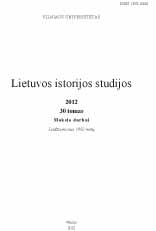ANTANO SNIEČKAUS SOVIETINIO PARTINIO ELITO KLANO FORMAVIMASIS 1956–1974 METAIS
The formation of Antanas Snieckus’ party elite clan, 1956–1974
Author(s): Marius ĖmužisSubject(s): History
Published by: Vilniaus Universiteto Leidykla
Summary/Abstract: The occupied Lithuania differs from the rest of the Soviet republics by the stability of its administration. The First Secretary of the Communist Party of Lithuania A. Snieckus led nearly 34 years; this was an unprecedently long period even by Soviet standards. Moscow was grateful to him for the stability and good economic performance, and for the capability to attract collaborators and conformists. They couldn’t rely solely on the occupying forces – a local elite had to emerge. But he had limited opportunities to form on its own in the conditions of the Soviet nomenclature system, a phenomenon through which all the highest-ranking individuals were assigned, more or less, by one person. Because the party elite had a lot of loyalty to A. Snieckus’ cadres, we may question Moscow‘s omnipotence in the republican cadre matters and to raise the problem of an emerging the Snieckus clan. The Soviet system was highly bureaucratic, but because of a dubbed, party and state, system, the power was concentrated in the hands of the individuals rather than institutions. In the Soviet system, the most influential figures were those with powerful connections and belonging to the clan. Clan members didn’t lose their influence even moving from post to post, because their clan representatives, hopping for the loyalty and support against other clans and Moscow, backed them up. The Bureau of the Communist Party of Lithuania, which always included the Central Committee secretaries, the chairman of the Council of Ministries, the chairman of the Presidium of the Supreme Soviet and other persons selected according to the influence, importance of the office, personal communication, Moscow’s wishes, or other criteria, was the most important institution of the occupied republic. The bureau solved even minor issues, and these decisions often influenced the life of all the republic and in particular the composition of the nomenclature. The most important person in the bureau and the CPL was the First Secretary, A. Snieckus. He occupied this post from 1940, but until the death of J. Stalin in 1953 his influence was very limited. The growth of the influence was determined by the authority and personal qualities of A. Snieckus, like charisma, and, of course, by the political changes in Moscow. Because of A. Snieckus’ personal charisma he was imagined as a master (owner) of the occupied land, and because of this image he could rely on a charisma-based leadership. Such circumstances allowed the expansion of the influence over the appointment of the party cadres. The selection of the most important posts in the republic, thanks to the nomenclature system, depended on a certain level of party organization. Key posts were approved by the bureau of the CPL, and all of the decrees were signed by A. Snieckus. Moscow confined to a formal candidate questionnaire-based data review and interviews with the candidate.
Journal: Lietuvos istorijos studijos
- Issue Year: 2012
- Issue No: 30
- Page Range: 129-149
- Page Count: 21
- Language: Lithuanian

